A History of Comets - Part 1
From harbingers of doom to celestial wanderers
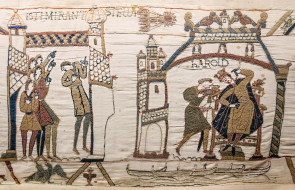 |
| Halley's Comet of 1066 represented in the Bayeux Tapestry (scenes 32-33). Credit: By Myrabella (Own work) [Public domain or CC0], via Wikimedia Commons |
Comets are not one-time visitors. Originating in the icy depths of our Solar System, they travel on elliptical orbits that swing around our Sun and return back, in most cases beyond the orbit of Neptune. These incredibly elongated orbits mean that it can take years – from a few to hundreds or even thousands – for a comet to reappear in our Solar System, throwing up difficult observational hurdles.
Ancient stargazers had little information to work with, having only seen a particular comet once in a human lifetime. The seemingly transient and unpredictable behaviour of comets rendered them completely mysterious, as they did not seem to fit in with our ancestors' growing understanding of celestial bodies and their motions. Rather than being viewed as beautiful and intriguing, comets were instead regarded as omens of impending doom, a reputation that took many centuries – and the efforts of many astronomers – to overcome.
From sky to stone
Despite their chequered early reputation, humans have been captivated by comets for much of history and have probably been gazing at them longer than any archaeological record can testify. Some archaeologists suggest that prehistoric rock paintings, found in several sites across the globe, may portray comets. Early rock carvings resembling comets have been found in Scotland dating back to the second millennium BC, and a comet-like shape found on rock carvings in Val Camonica, Italy, dates back to the late Iron Age.
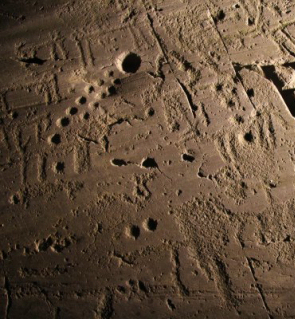 |
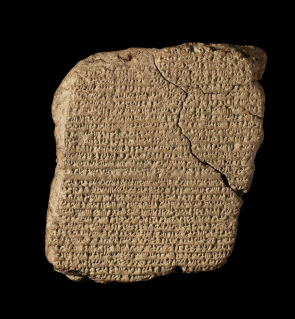 |
| Comet symbol on Rock 35 from Area di Foppe, Nadro di Ceto (Brescia, Italy). Riserva naturale Incisioni rupestri di Ceto, Cimbergo e Paspardo. Copyright: Centro Camuno di Studi Preistorici, Dipartimento Valcamonica e Lombardia | Babylonian tablet recording Halley's Comet of 164 BCE. Credit: © Trustees of the British Museum |
The first systematic observations of the sky are credited to the Chaldeans, who lived in the region of ancient Babylon, or modern day Iraq. They started practicing astronomy during the third millennium BC, the time of the Bronze Age, and left detailed records on a vast number of clay tablets. While explicit references to comets have to date only been found on Chaldean tablets from the last few centuries BC, indirect sources, such as the Roman philosopher Seneca, report that Chaldean astronomers had long had a keen interest in these unpredictable objects, most likely developing some quite sophisticated ideas about their nature.
Chinese astronomers were also fascinated by comets. They kept the most complete body of ancient observations of comets ever found, dating back to the 11th century BC. A Chinese book known as The Mawangdui Silk Texts, an almanac transcribed on silk in the fourth century BC, is the first known illustrated catalogue of comets. This book documents a variety of comets in great detail, commenting on the appearance, path, and peculiar properties of each comet, including the number of tails, for example.
But this almanac also included an additional record that has accompanied comet-gazing for a long stretch of history: listed were details of the catastrophe or disaster thought to be associated with each comet, illustrating the dread and fear once caused by these cosmic "harbingers of doom".
Ancient views
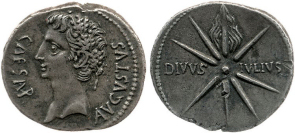 |
|
Roman silver coin with a depiction of the head of emperor Augustus, and on the other side the comet of 44 BC, associated with the death and subsequent divinisation of Julius Caesar. Credit: © Trustees of the British Museum |
Ancient Greek philosophers put forward a number of different ideas to explain the physical nature of comets. To some, comets were celestial bodies just like planets. To others, they were linked to celestial mechanics such as planetary conjunctions, and to yet others they were burning clouds or optical phenomena in the Earth's atmosphere. Although far from correct, the latter view was adopted by Aristotle in the fourth century BC, and prevailed for some 2000 years.
According to Aristotle, Earth was at the centre of the Universe, with the Moon, Sun, and the other Solar System planets known at the time orbiting it. This view left no room for comets, so Aristotle suggested that they were "windy exhalations" from the Earth that reached out into our atmosphere. Viewing comets as atmospheric phenomena made it easier to connect their appearance to earthly – and inauspicious – events, and so Aristotle's theory provided fertile ground for the fear and superstition that plagued comets for centuries.
The only voice that dared contradict this view was that of Seneca, in the first century BC. According to Seneca's Naturales Quaestiones, various interpretations of comets as either atmospheric phenomena or celestial bodies had already been developed by Chaldean astronomers. Seneca himself believed that comets were more like planets than Aristotle's "windy exhalations". He also recognised that their sporadic behaviour would make studying them quite complex, but hoped that future observations and investigations would shed light on their nature.
Becoming modern
Aristotle's view of the heavens dominated almost undisputed throughout the Middle Ages. This situation started to change, however, with the dawn of the Renaissance in Europe, which reignited a scientific interest in studying the natural and physical world.
New ideas emerged as astronomers assembled an increasingly larger body of data. In the fifteenth century, Italian scientist Paolo dal Pozzo Toscanelli conducted the first systematic observations of several comets. He recognised the importance of measuring both the orientation of the comet's coma – the nebulous envelope surrounding the comet's nucleus – and the position of the nucleus. In the sixteenth century, German astronomer Peter Apian and the Italian scientist Girolamo Fracastoro realised that a comet's tail always points away from the Sun – a revelation that would be key to correctly interpreting these objects and their physics.
Our understanding of comets experienced a dramatic leap forward with the appearance of a Great Comet in 1577. Great Comets are rare and exceptionally bright – so bright that they can be easily spotted by someone just glancing at the sky. The Great Comet of 1577 was as bright as Venus and boasted a tail that stretched over a patch of sky some forty times the diameter of the full Moon. This offered Danish astronomer Tycho Brahe a unique opportunity.
Starry shifts
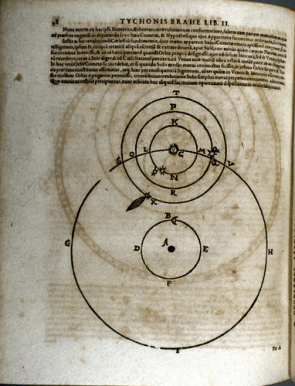 |
| The path of the comet Tycho Brahe saw in 1577, in his hybrid geo/heliocentric model. Image courtesy History of Science Collections, University of Oklahoma Libraries. (available online) [Public domain or CC0], via Wikimedia Commons |
Brahe, the last great astronomer before the invention of the telescope, decided to try and estimate the distance to this comet by measuring its parallax – a concept related to perspective.
One of the methods used to measure distances to landmarks on the Earth's surface involves looking at the landmark from two separate locations. Its observed position shifts against even more distant objects in the background, due to a difference in perspective – similar to the apparent movement you see if you hold your finger at arm's length and view it alternately through each eye. This shift, called parallax, is larger for closer objects than for more distant ones.
Observing the Great Comet of 1577 from Denmark, Brahe noticed that the comet's position in the sky differed very little from similar measurements performed by other astronomers across Europe. The difference should have been much larger had the comet been relatively close to Earth, either at or within the orbit of the Moon.
From Brahe's calculations, the comet appeared to be at least four times farther than the Moon, so he deduced that it must belong to the heavens, not to our atmosphere. This was reflected in the revision of Brahe's model of the Universe - a hybrid between the classical geocentric model, and the heliocentric one that had been proposed in 1543 by Polish astronomer Nicolaus Copernicus – to include comets.
Finally, the great debate about the nature of comets – atmospheric phenomena or celestial bodies – was settled. But this was only the beginning: a new era of inquiry about comets, planets, and the fundamental physics that governs their motions was about to commence.
|
A History of Comets - Part 2: Testing gravity: How comets helped to prove Newton right |
> | |||
